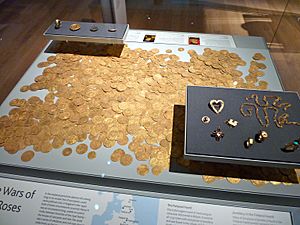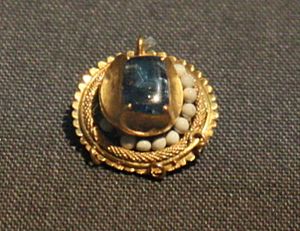Fishpool Hoard facts for kids

Imagine finding a huge treasure! That's what happened in 1966 when the Fishpool Hoard was discovered. This amazing find included 1,237 gold coins from the 1400s. It also had four rings, four other pieces of jewellery, and two long gold chains. Workmen found it on a building site near what is now Cambourne Gardens, in a place called Ravenshead, Nottinghamshire, England. Back then, this area was known as "Fishpool."
This hoard is the biggest collection of medieval coins ever found in Britain!
Contents
The Amazing Fishpool Hoard
What Was Found?
The Fishpool Hoard is famous for its large number of gold coins. These coins help experts understand money from the 15th century. Besides the coins, the hoard contained beautiful gold jewellery. This included rings, pendants, and a special heart-shaped brooch. Some items had shiny gems or colourful enamel.
Why Was It Buried?
Experts believe the hoard was hidden quickly between late 1463 and mid-1464. This timing is important because England was in the middle of a big civil war. This war was called the War of the Roses. It was a fight between powerful families for control of the country.
Someone might have buried the treasure while running away. This could have been after a battle called the Battle of Hexham in May 1464. Hiding such a valuable hoard was a way to keep it safe during dangerous times.
Its Value and Importance
When it was buried, the hoard was worth about £400. Today, that would be like having around £300,000! The Fishpool Hoard is now on display at the British Museum in London. It's in Room 40, where many other incredible treasures are kept.
In 2003, the hoard was even featured on a BBC Television show. It was listed as one of "Our Top Ten Treasures" in a special episode of Meet the Ancestors. Experts from the British Museum chose it as one of the most important treasures found in Britain.
The Coins and Jewellery
The coins in the hoard showed that older gold coins were still used. Even some fake, gold-plated coins from the time of King Henry VI were found.
The jewellery is all made of gold. Some pieces have gems or colourful enamel. There are four rings, three pendants, and a heart-shaped brooch. The brooch has a loving message: "je suys vostre sans de partier." This means "I am yours wholly." One tiny pendant looks like a padlock. It says "de tout" on one side and "mon cuer" on the other. This means "of all ... my heart."
One ring has a turquoise gem. People believed turquoise could protect the wearer. It was thought to guard against drowning, poison, and riding accidents. The rings are probably English. However, some other jewellery items might have been made in Flanders, a region in modern-day Belgium.


